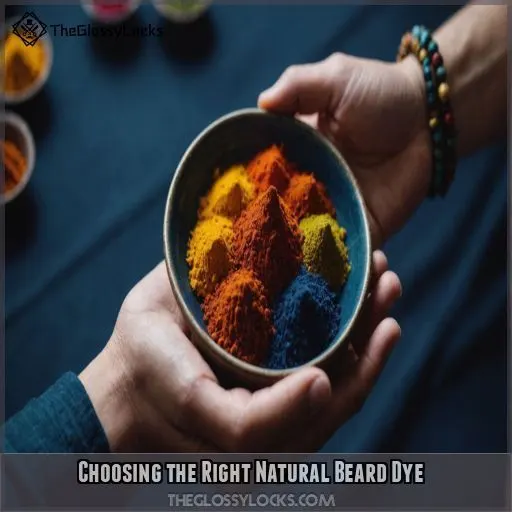This site is supported by our readers. We may earn a commission, at no cost to you, if you purchase through links.
 Ditch the harsh chemicals and take control of your beard’s look and health!
Ditch the harsh chemicals and take control of your beard’s look and health!
Dyeing your beard naturally is a game-changer.
With a few simple steps, you can achieve a fresh new look that’s all you.
First, choose a natural dye that suits your skin type – henna is a great option.
Then, Then, mix it with a natural ingredient like lemon juice or coffee to create a paste, and consider using sulfate-free shampoos for a gentler beard care routine.
.
Apply it evenly to your beard, focusing on those gray areas.
Process for 20-45 minutes, rinse, and condition.
You’ll be rocking a vibrant, natural-looking beard in no time!
But, what’s the secret to maintaining that color?
Table Of Contents
- Key Takeaways
- Why Dye Your Beard Naturally?
- Choosing the Right Natural Beard Dye
- How to Dye Your Beard Naturally: a Step-by-Step Guide
- Natural Beard Color Vs. Beard Dyes: What’s the Difference?
- Tips for a Natural-Looking Beard Color
- Frequently Asked Questions (FAQs)
- How do I color my beard naturally?
- How can I naturally darken my beard?
- How to turn grey beard to black naturally?
- How can I color my beard without skin coloring?
- Can I dye my beard while having skin conditions?
- How often should I touch up my natural beard color?
- Will natural beard dye work on very gray beards?
- Can I mix different natural dye colors for a custom shade?
- Are there any natural beard dyes suitable for sensitive skin?
- Conclusion
Key Takeaways
- Take control of your look: Ditch harsh chemicals and try natural dyeing to get the color you want without the damage. Yes, it’s time to level up your beard game and take charge of your style!
- Get to know your skin: Before you start dyeing, make sure you know what works for your skin (and what doesn’t). Try out natural options like henna or look for products that are specifically labeled as "skin-safe" or "dermatologist-tested".
- Mix and match: Want a custom shade? Mix different natural dye colors to create the perfect blend for you. It’s like cooking with new spices in the kitchen – experiment and have fun with it!
- Keep it up, keep it green: Need to touch up your color? Aim to do it every 4-6 weeks to keep your beard looking its best and the planet happy too. It’s a win-win!
Why Dye Your Beard Naturally?
You’re probably thinking of dyeing your beard naturally because you want to look younger, feel more confident, or simply try out a new aesthetic that matches your head hair. By ditching harsh chemicals and opting for a natural approach, you can achieve a fresh new look that’s better for your skin but also good for the environment.
Boosting Confidence With a Natural Look
Ditch harsh chemicals and boost your confidence with a natural look! Dyeing your beard naturally can be a game-changer for your self-image. Here’s why:
- Enhances your natural features
- Gives you a sense of control and freedom
- Boosts your self-esteem and confidence
- Allows for a customized look that suits your style
- Promotes a positive self-image
Achieving a Younger Appearance
Now that you know how a natural look can boost your confidence, let’s talk about achieving a younger appearance. A well-groomed beard can take years off your face, but grey hair can have the opposite effect. By dyeing your beard naturally, you can cover those greys and achieve a more youthful look.
Enhancing Aesthetic Appeal
You’re not just growing a beard, you’re crafting a beard style
, you’re crafting a look! Dyeing your beard naturally can enhance your aesthetic appeal, making you feel more confident and put-together. With natural beard care, you can try out new beard styles and color trends without harsh chemicals. Discover your unique beard color inspiration and own your fresh new look!
Choosing the Right Natural Beard Dye
Choosing the right natural beard dye can be tricky. You’ll probably want to think about a few key factors, like your skin type, the level of maintenance you’re willing to commit to, and the shade that’ll make you look and feel like the best version of yourself.
Henna as a Natural and Safe Alternative
Henna is a great natural and safe alternative for dyeing your beard.
It’s a game-changer for beard dyeing, offering a range of color options, from subtle to bold.
With henna, you can achieve a natural-looking beard color without harsh chemicals.
It’s perfect for gray coverage and is easy to maintain.
Selecting a Dye That Suits Your Skin Type
When dyeing your beard naturally, selecting a dye that suits your skin type is important. If you have sensitive skin, you’re likely no stranger to dye allergies and skin irritation. Always do a patch test to make sure you’re not allergic to the natural ingredients. This simple step can save you from a world of discomfort and skin sensitivity issues.
Considering Hypoallergenic Options
Considering Hypoallergenic Options (Choosing the Right Natural Beard Dye)
Now that you’ve found a dye that suits your skin type, it’s time to think about hypoallergenic options. If you have sensitive skin or a dye allergy, look for natural ingredients that won’t irritate your skin. Try a patch test before applying the dye to make sure you won’t have any adverse reactions.
How to Dye Your Beard Naturally: a Step-by-Step Guide
You’re ready to ditch harsh chemicals and give your beard a fresh new look with natural dye. In this step-by-step guide, you’ll learn how to prepare your face and beard, mix and apply the natural dye, and maintain your new color with ease.
Preparing Your Face and Beard for Dyeing
Get ready to take control of your beard’s color! Before dyeing, Before dyeing, prep your face and beard by trimming any stray hairs and applying a thin layer of beard oil benefits or balm to protect your skin.
. Throw on an old shirt and grab a towel to shield your surfaces from stains. Your skin (and surfaces) will thank you!
Mixing and Applying the Natural Dye
Now it’s time to mix and apply the natural dye.
Think of this step as the "magic" part of the process.
Combine your henna powder with a natural ingredient like lemon juice or coffee to create a paste.
Apply the mixture evenly to your beard, starting with the gray areas.
Use a brush or applicator bottle to get the job done.
Processing and Rinsing the Dye
Now that you’ve applied the natural dye, it’s time to let it work its magic. Follow the recommended processing time, usually 20-45 minutes, depending on the product. Then, rinse your beard thoroughly with warm water to remove excess dye. Use a gentle shampoo and conditioner to keep your skin and hair protected, much like minimizing heat damage when styling your hair.
.
Maintaining and Touching Up Your Natural Color
Now that you’ve achieved your desired natural color, it’s time to maintain it.
To prevent color fading, reapply your natural dye every 4-6 weeks.
For touch-ups, blend a small amount of dye with your regular hair care products.
Use a color-fixing shampoo to keep your color vibrant.
With regular maintenance, you’ll enjoy a healthy, natural-looking beard that makes you feel confident and in control.
Natural Beard Color Vs. Beard Dyes: What’s the Difference?
If you’re thinking about dyeing your beard, you’ve got two main options: If you’re thinking about dyeing your beard, you’ve got two main options: natural beard dye options or traditional beard dyes.
. If you’re considering making the switch to a more natural approach, you need to understand the pros and cons of each option and how they compare to help you make an informed decision for your beard.
Understanding the Pros and Cons of Natural Beard Color
So, you’re considering natural beard color – what’re the pros and cons? Here’s the lowdown:
- Pros:
- Quick application (under 60 seconds)
- Hypoallergenic
- Customizable look
- No "shoe-polish" beard
- Cons:
- Must be reapplied every other day
- Not as color-longevous as traditional dyes.
Comparing Natural Beard Color to Traditional Beard Dyes
If you’re thinking about dyeing your beard, you’ve got two choices: If you’re thinking about dyeing your beard, you’ve got two main options: natural beard dye options or traditional beard dyes.
. Let’s compare them side by side.
| Natural vs. Chemical | Natural Beard Color | Traditional Beard Dyes |
|---|---|---|
| To achieve optimal color longevity, consider using a Japanese hair dye that offers long-lasting color with fade-resistant natural pigments. | Fades within days | Lasts until roots grow out |
| Skin Sensitivity | Hypoallergenic, gentle | May contain harsh chemicals |
| Application Ease | Quick, under 60 seconds | Longer application time |
| Cost Comparison | Single vial lasts longer | Multiple applications required |
Consider what matters most to you when deciding which route to take.
Making an Informed Decision for Your Beard
Now that you’ve weighed the pros and cons, it’s time to make an informed decision for your beard. Consider the following key factors:
- Beard dye safety: Are you willing to risk harsh chemicals?
- Cost comparison: Natural dyes might be more cost-effective in the long run.
- Allergy concerns: Do you have sensitive skin that could react to dyes?
- Color fading: How often are you willing to touch up your color?
- Shade selection: Can you find a natural dye that matches your desired shade?
Tips for a Natural-Looking Beard Color
When you’re trying to achieve a natural-looking beard color, it’s all about finding the right balance – you want to enhance your natural hue without looking like you’re trying too hard. By following a few simple tips and tricks, you can get a natural-looking beard color that makes you feel confident and put-together, without the harsh chemicals.
How to Avoid an Unnatural Look With Natural Dye
To avoid an unnatural look with natural dye, start by choosing a shade that complements your skin tone. Color blending is key, so experiment with different hues to find the perfect match. Apply the dye evenly, focusing on patchy areas first, and consider a lighter touch for a more natural finish.
Using Temporary Beard Color for a Natural Look
You’ve mastered the art of natural dyeing, now it’s time to take it to the next level with temporary beard color! This game-changer is perfect for a natural look without the long-term commitment. Here are some tips to get you started:
- Choose a shade that complements your skin tone for a seamless blend.
- Apply it evenly to avoid patchy spots.
- Blend, blend, blend for a natural-looking finish.
Temporary beard color is a great way to add some dimension to your beard without the hassle of permanent dye.
Maintaining a Natural-Looking Beard Color With Regular Touch-Ups
To maintain a natural-looking beard color, you’ll need to touch up your dye job regularly. Aim to re-dye every 4-6 weeks to prevent color fading and patchy beards. Use natural products to minimize damage and follow a consistent touch-up routine. This will keep your beard looking healthy, vibrant, and full of life.
Frequently Asked Questions (FAQs)
How do I color my beard naturally?
To color your beard naturally, try henna or natural dyes like Volt Beard Color. These options are hypoallergenic, customizable, and sustainable. Simply shake, brush on, and wait 30 seconds for a quick, natural-looking color.
How can I naturally darken my beard?
You can naturally darken your beard with henna, a plant-based dye. Mix henna powder with lemon juice and tea, then apply to your beard, leaving it on for 1-2 hours before rinsing.
How to turn grey beard to black naturally?
Going grey got you down? You’re not alone! Many guys struggle with grey beards. To turn yours black naturally, try henna or a natural beard dye. It’s a game-changer for a youthful look!
How can I color my beard without skin coloring?
To color your beard without skin coloring, consider using henna, a natural dye, or look for products specifically labeled as "skin-safe" or "dermatologist-tested". Always follow instructions and do a patch test first.
Can I dye my beard while having skin conditions?
Carefully consider whether to dye your beard with skin conditions, as harsh chemicals might exacerbate issues. Opt for hypoallergenic dyes or try natural alternatives like henna to minimize potential irritation.
How often should I touch up my natural beard color?
You should touch up your natural beard color as needed, ideally every 2-3 days, depending on how quickly your beard grows and sheds. This will help maintain a consistent look and prevent fading.
Will natural beard dye work on very gray beards?
You can definitely use natural beard dye on very gray beards, but it mightn’t cover large patches completely – it’s perfect for filling in thinning areas and adding a healthy-looking glow.
Can I mix different natural dye colors for a custom shade?
You totally can mix different natural dye colors to create a custom shade. Experiment with different combos, like combining henna with beetroot powder for a reddish-brown hue. Excite and enjoy!
Are there any natural beard dyes suitable for sensitive skin?
Your beard is begging for a change, and your skin is screaming ‘help!’ Don’t worry, there are natural beard dyes perfect for sensitive skin, including henna and plant-based options like berry-based colors.
Conclusion
Ditching harsh chemicals is a game-changer for your beard – and your wallet!
Now that you’re informed on how to dye your beard naturally, don’t let faded colors get you down.
You’ve taken control of your look and are rocking that natural style.
How to dye your beard naturally is all about finding what works for you and making adjustments as needed.
Keep your color vibrant and healthy with regular touch-ups – your beard (and the planet) will thank you!








